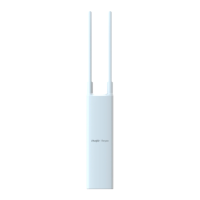Web-based Configuration Guide Network Settings
118
as 2001:CD:34:78:A:B:1200:2100.
Consecutive 0s can be replaced by two colons (::). For example, 800:0:0:0:0:0:0:1 can be written as 800::1.
Consecutive 0s can be replaced by two colons only when the 16-bit section contains all 0s, and the two
colons can only appear once in the address.
2. IPv6 Prefix
An IPv6 address consists of two parts:
Network prefix: It contains n bits, and is equivalent to the network ID in an IPv4 address.
Interface identifier: It contains (128 - n) bits, and is equivalent to the host ID in an IPv4 address.
The length of the network prefix is separated from the IPv6 address by a slash (/). For example,
12AB::CD30:0:0:0:0/60 indicates that the length of the prefix used for routing in the address is 60 bits.
3. Special IPv6 Address
There are also some special IPv6 addresses, for example:
fe80::/8 is a link local address, and equivalent to 169.254.0.0/16 in IPv4.
fc00::/7 is a local address, and similar to 10.0.0.0/8, 172.16.0.0/16, or 192.168.0.0/16 in IPv4.
ff00::/12 is a multicast address, and similar to 224.0.0.0/8 in IPv4.
4. NAT66
IPv6-to-IPv6 Network Address Translation (NAT66) is the process of converting the IPv6 address in an IPv6
packet header to another IPv6 address. NAT66 prefix translation is an implementation of NAT66. It replaces the
IPv6 address prefix in the packet header with another IPv6 address prefix to achieve IPv6 address translation.
NAT66 can realize mutual access between an intranet and Internet.
4.16.3 IPv6 Address Assignment Methods
Manual configuration: The IPv6 address/prefix and other network configuration parameters are manually
configured.
Stateless Address Autoconfiguration (SLAAC): The link local address is generated based on the interface ID,
and then the local address is automatically configured based on the prefix information contained in the route
advertisement packet.
Stateful address autoconfiguration, that is, DHCPv6: DHCPv6 is divided into the following two types:
○ DHCPv6 autoconfiguration: The DHCPv6 server automatically configures the IPv6 address/prefix and
other network configuration parameters.
○ DHCPv6 Prefix Delegation (PD): The lower-layer network device sends a prefix allocation application to
the upper-layer network device. The upper-layer network device assigns an appropriate address prefix
to the lower-layer device. The lower-layer device automatically subdivides the obtained prefix (generally
less than 64 bits in length) into subnet segments with 64-bit prefix length, and then advertises the
subdivided address prefixes to the user link directly connected to the IPv6 host through the route to
realize automatic address configuration of the host.
4.16.4 Enabling IPv6
In Local Device mode, choose Network > IPv6 Address.

